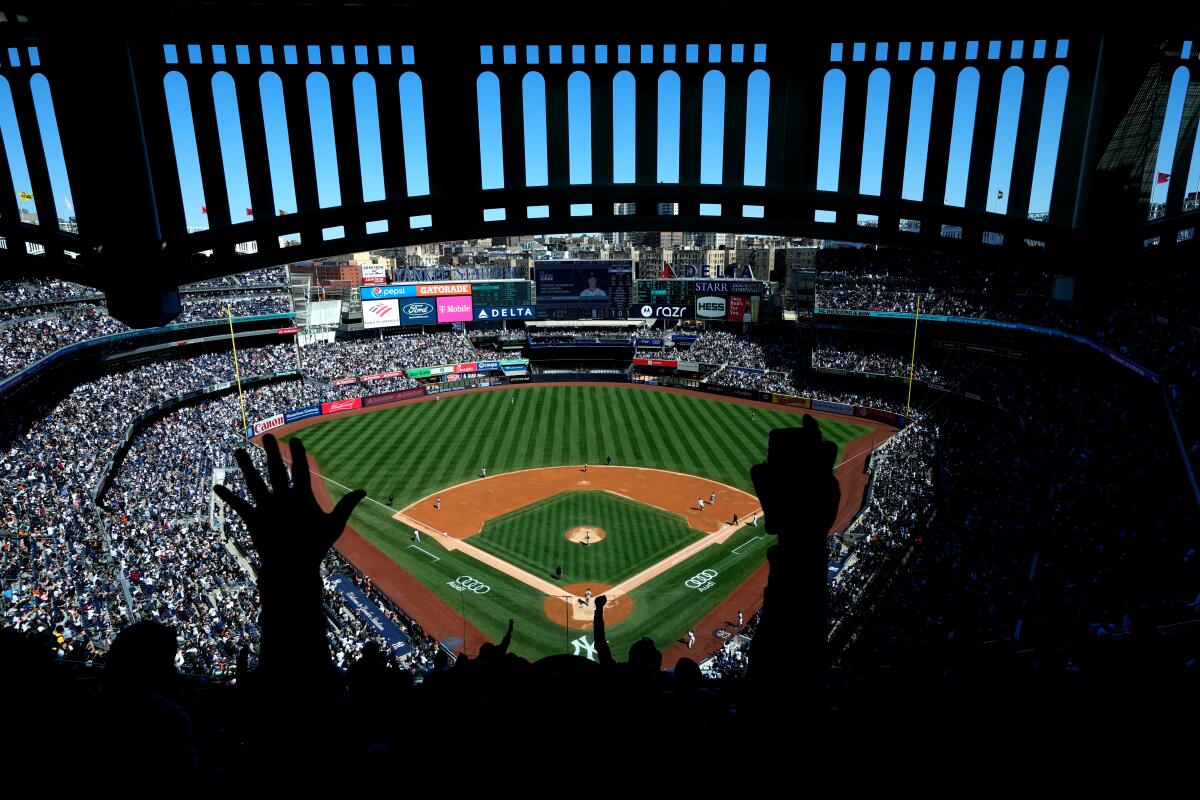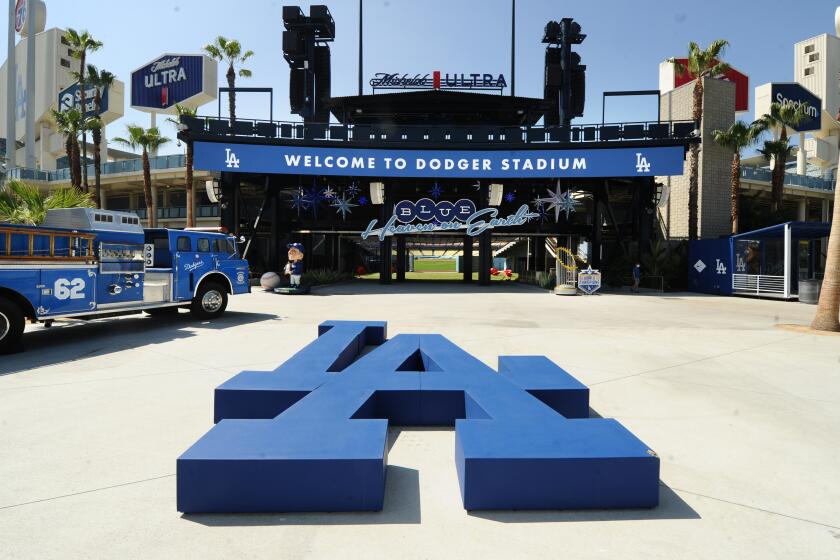Dodger Stadium vs. Yankee Stadium: Why L.A. beats N.Y. in a battle of architecture

The Dodgers and Yankees, two of the most storied franchises in baseball history, have similar win-loss records this season and two of the biggest payrolls in sports. But though the World Series teams match up closely on paper, thereâs one category where the Dodgers have a clear edge: their stadium.
Dodger Stadium, born in 1962 and now the third oldest park in baseball after Chicagoâs Wrigley Field and Bostonâs Fenway Park, is a jewel of a place that to this day captures the quirky, futuristic, giddily optimistic spirit of midcentury Los Angeles in what is possibly baseballâs most bucolic setting (minus the ridiculous, sprawling parking lot).
Yankee Stadium, which was rebuilt in 2009, is no slouch either. Itâs a monumental, energetic place in the heart of the booming Bronx that evokes a storied era in baseball history. But ultimately itâs a facsimile: a new stadium hiding in throwback clothing. As hard as it tries â and it really tries â it canât re-create the original Yankee Stadiumâs spirit.
Intuit Dome is a sleek, joyous piece of modern architecture with much to love, just like its neighbor, SoFi Stadium. But around its edges, the picture gets a little fuzzier.
The complex story of how we got here represents how architecture, cities and popular opinion can dramatically shift over time. It was the Dodgers, of course, who first abandoned their historic home, the shabby but beloved Ebbets Field (1913), in the heart of what was then equally shabby Brooklyn, in 1957. Owner Walter OâMalley had wanted to build a new park nearby but didnât get support from New Yorkâs wannabe pharaoh, urban planner Robert Moses. So OâMalley and his team fled the East Coast for a sparkling new facility being built in L.A., above the flattened remains of the predominantly Mexican American neighborhood known as Chavez Ravine.
The site had been cleared for a public housing development called Elysian Park Heights, and OâMalley hired Emil Praeger â a New York engineer who had designed piers, bridges and even a breakwater used during the Allied invasion of Normandy â to create a futuristic stadium that looked resolutely forward, true to the spirit of its time. With its its powdery pastel colors, zigzag metal canopies, space-age scoreboard and verdant terraces filled with UFO-shaped urns, Dodger Stadium lived up to the hype. It still does.
The teamâs various owners have kept renovating, maintaining the parkâs form and integrity while refreshing it for current needs and rules. Some of the most significant updates have been a village-like new center field plaza filled with food, entertainment and retail; wider concourses; improved concessions and bathrooms; drought-tolerant landscaping; new luxury boxes and revamped audio and video systems.

Hey Yankees fans, think you got the best food city? Los Angeles has better tacos and burgers and â yes, even better pastrami, pizza and bagels. L.A. is the superior food city. Full stop.
By contrast, Yankee Stadium, built in 1923 by Osborn Engineering (authors also of legendary parks like Fenway and Tiger Stadium in Detroit) had long been a monumental beacon of history in a city known for convulsing change. One of the first true baseball âstadiums,â in contrast to quainter âballparks,â the âHouse That Ruth Builtâ included multiple decks wrapping around the field, allowing for the largest seating capacity in the sport. Its hulking form and heavy materials â oceans of granite, limestone and concrete â created an intimidating place that stood for strength, power and winning.
But after it became clear the stadium needed a refresh in the 1970s, new owner George Steinbrenner delivered a characteristically heavy-handed renovation, bringing the park up to modern standards but replacing some of its classic design elements, such as the stately entrance and crowning frieze, with awkward, utilitarian elements like a spiral entry ramp and a smaller, clunkier frieze in the outfield. In the mid-aughts, the team decided another refresh was infeasible and opted for a teardown instead of a remodel. By 2009 they had opened a new Yankee Stadium, right next to the original.

Parking will move underground, creating six acres of green space where asphalt used to be. Thatâs just one change in a charge being led by Expo Parkâs new 40-year-old general manager, Andrea Ambriz.
Its design team was led by sports architecture firm Populous, which has designed dozens of ballparks, from Baltimoreâs Oriole Park at Camden Yards to the New York Metsâ Citi Field. Populous moved heaven and earth to make a bigger, more comfortable version of the original Yankee Stadium. They kept the field dimensions, re-created the limestone and granite façade, preserved views up to the elevated rail tracks and approximated the original frieze above the upper deck. Their seats, concourses and bathrooms are more pleasant than the originalâs, and the building meets nearby streets in a more people-friendly manner.
And yet, the new Yankee Stadium feels a little vapid â like youâre visiting a tribute to a once-great place, not the place itself. Itâs a Yankees-themed variation on any number of faux historic stadiums. My wife likens it to going to a corporate event or a theme park â an âofficially licensed experience.â Or even worse, like a day at Angel Stadium.
Of course sports are a business, and owners shouldnât keep their buildings alive out of a sense of duty. But what the Dodgers have gotten right is that you canât re-create a classic. You can, though, keep improving on it â often in creative ways. And it pays. According to Major League Baseball, Dodger Stadium has had the highest attendance in the sport for the last 10 years. Of course L.A. is a huge market and has a very good team, but the stadium is certainly helping, not hurting, the bottom line.
Dodger Stadium was renovated ahead of the 2020 season, but fans have yet to experience any of it. What can they look forward to in 2021.
There are so many more reasons to preserve and enhance existing stadiums. Given our environmental crisis, thereâs no excuse for the epic waste involved with tearing down and starting over. And given the significant advances that have been made in restoration and reuse â which now, according to the American Institute of Architects, represent more than half the construction market â doing so can be more feasible, and inventive, than ever.
Preserving buildings means preserving their memories. Any structure is a living embodiment of history, and many stadiums are hallowed ground to their fans. Roger Maris didnât break the single-season home record in the new Yankee Stadium, nor did legends like Babe Ruth, Mickey Mantle, Joe DiMaggio and Reggie Jackson make their marks there. But Sandy Koufax did pitch his perfect game at Dodger Stadium, and Kirk Gibson hit his World Series walk-off here. These things matter to the significance of a place, as do its original quirks, creative adaptations and the thousands of hours that generations of fans have spent there, cheering, crying and building a home away from home. When a place dies, the most potent container of its history dies with it. Yankee Stadium is a good place to watch baseball. But Dodger Stadium is a treasure, not just to Los Angeles, but to baseball.

More to Read
The biggest entertainment stories
Get our big stories about Hollywood, film, television, music, arts, culture and more right in your inbox as soon as they publish.
You may occasionally receive promotional content from the Los Angeles Times.














